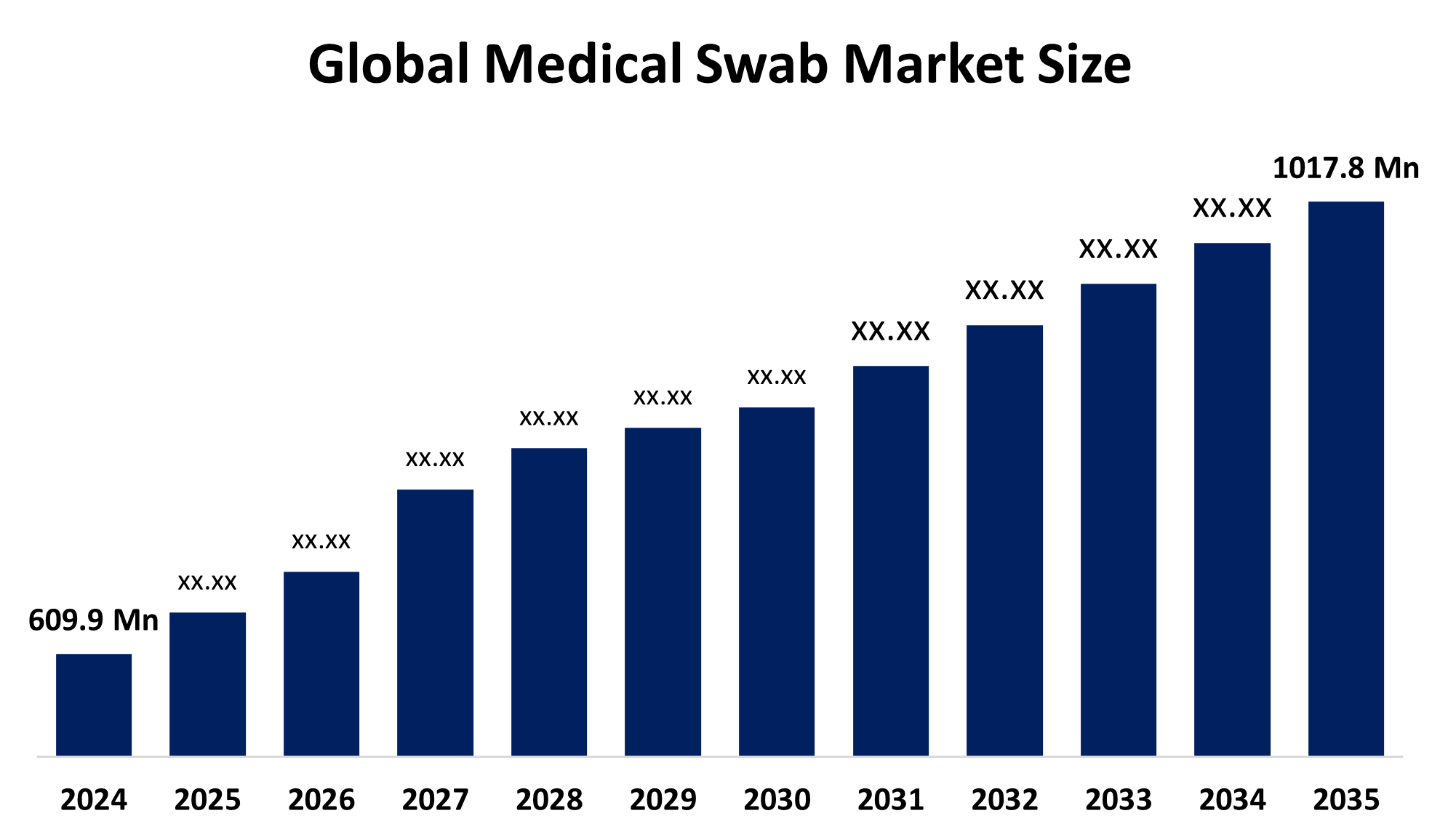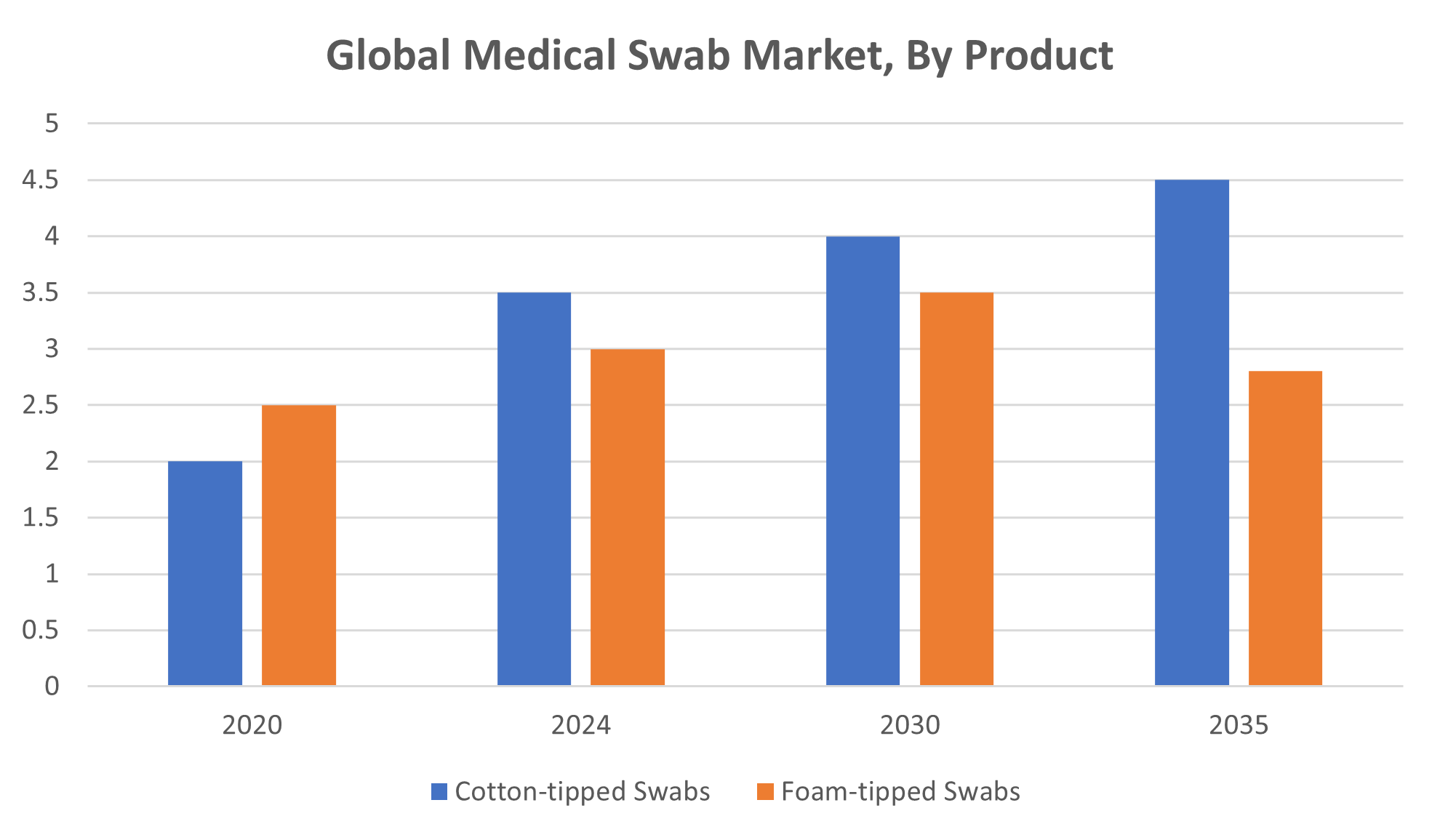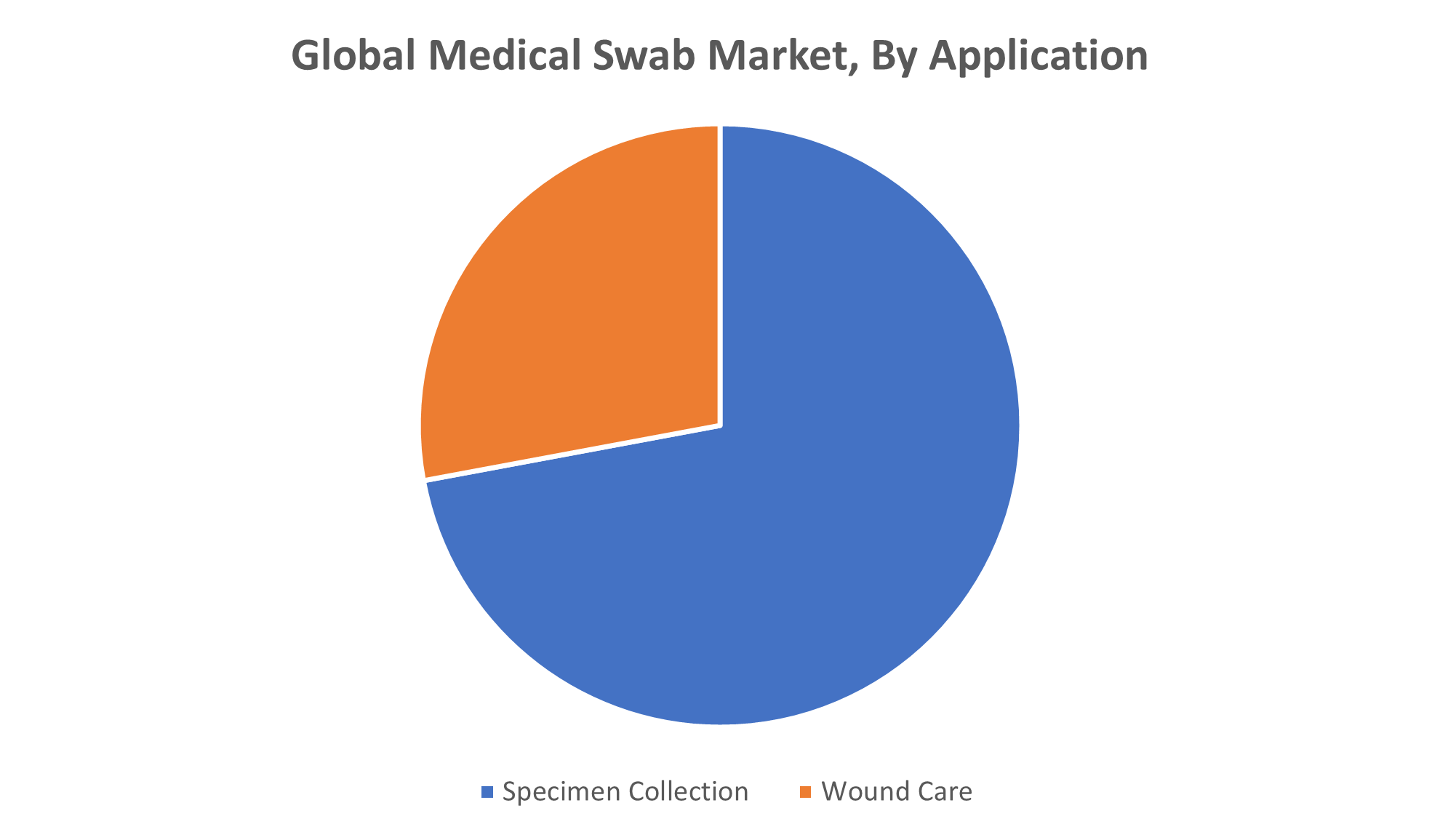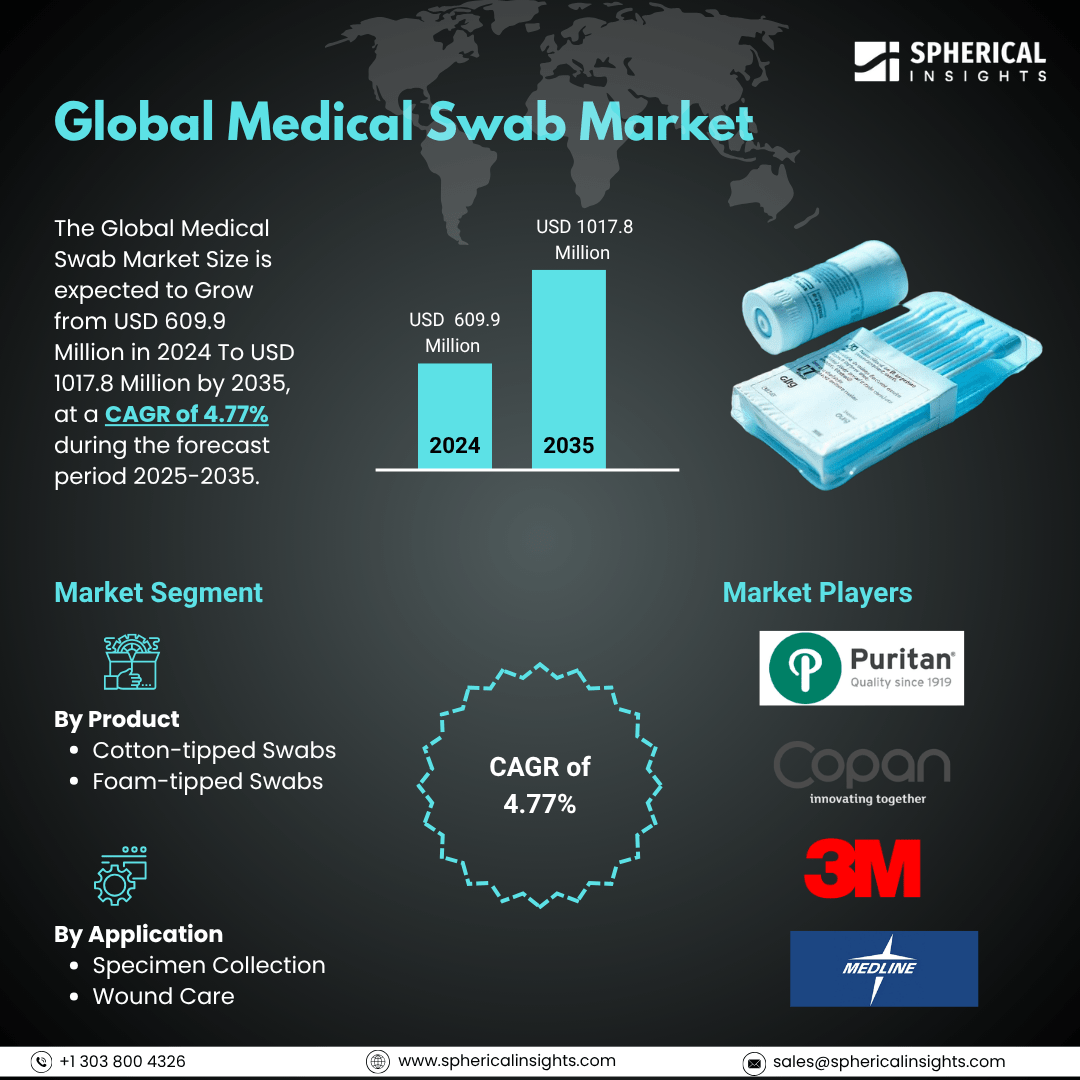Global Medical Swab Market Insights Forecasts To 2035
- The Global Medical Swab Market Size Was Estimated at USD 609.9 Million in 2024
- The Market Size is Expected To Grow at a CAGR of around 4.77% from 2025 to 2035
- The Worldwide Medical Swab Market Size is Expected to Reach USD 1017.8 Million by 2035
- Asia Pacific is Expected To Grow the fastest during the forecast period.

Medical Swab Market
The medical swab market includes sterile, single-use tools designed for collecting biological samples from various body sites such as the throat, nose, wounds, and other surfaces for diagnostic testing. These swabs play a crucial role in microbiological, virological, and molecular analyses in healthcare settings. They come in various types, including cotton, foam, and flocked swabs, each suited for different sampling needs. Medical swabs are widely used in hospitals, diagnostic laboratories, and research facilities to assist in detecting infectious diseases and monitoring patient health. The market offers products that ensure sterility and patient comfort while supporting accurate sample collection and transportation. Innovations focus on improving material quality and design to optimize specimen collection and compatibility with laboratory testing methods. Overall, the medical swab market serves as an essential segment within the broader healthcare and diagnostics industry, facilitating efficient and reliable sample collection for accurate diagnosis and treatment decisions worldwide.
Attractive Opportunities in the Medical Swab Market
- The rising focus on personalized healthcare drives demand for swabs that enable quick and accurate sample collection outside traditional laboratories. Point-of-care diagnostics require easy-to-use swabs for rapid testing, supporting faster clinical decisions. This trend opens avenues for innovative swab designs tailored for home or remote use, enhancing patient convenience and diagnostic efficiency.
- Environmental concerns over disposable medical waste are pushing the industry toward sustainable alternatives. The development of biodegradable and eco-friendly swabs addresses regulatory pressures and growing consumer demand for green products. Investing in these innovations creates a competitive edge and taps into a niche yet expanding market segment focused on sustainability.
- The surge in telemedicine and remote healthcare solutions is increasing the need for self-administered swabs. These swabs enable convenient and safe sample collection from home, improving access to diagnostic services in remote or underserved areas. This trend supports broader adoption of medical swabs beyond traditional clinical settings, driving market expansion.
Global Medical Swab Market Dynamics
DRIVER: Technological advancements in swab materials
The widespread need for effective sample collection methods to detect infectious diseases has significantly boosted swab usage. Technological advancements in swab materials, such as flocked and foam swabs, enhance sample collection efficiency and patient comfort, further encouraging adoption. Growing awareness about infection prevention and control measures in healthcare settings also supports market growth. Additionally, the expansion of healthcare infrastructure and diagnostic laboratories worldwide increases the availability and accessibility of medical swabs. Rising prevalence of infectious diseases and routine screening practices in hospitals and clinics further contribute to the market’s expansion. Moreover, the integration of swabs with automated diagnostic platforms improves testing speed and accuracy, making them indispensable in modern medical diagnostics.
RESTRAINT: Stringent regulatory requirements and the need for high-quality
Stringent regulatory requirements and the need for high-quality, sterile manufacturing processes increase production costs, making medical swabs relatively expensive for some healthcare providers. Supply chain disruptions, especially during global emergencies, can also impact the consistent availability of swabs. Moreover, the market is highly competitive with many low-cost alternatives, which may affect the profit margins of manufacturers offering premium products. In some regions, limited healthcare infrastructure and lack of trained personnel to properly collect samples can hinder market penetration. Lastly, environmental concerns regarding the disposal of single-use swabs contribute to regulatory pressures, pushing the industry towards sustainable alternatives that are yet to be widely adopted. These factors collectively restrain the rapid growth of the medical swab market.
OPPORTUNITY: Growing investments in personalized medicine and point-of-care diagnostics
Growing investments in personalized medicine and point-of-care diagnostics present new avenues for swab innovation, enabling faster and more precise sample collection outside traditional lab settings. Emerging markets, particularly in Asia-Pacific and Latin America, offer untapped potential due to expanding healthcare infrastructure and increasing access to diagnostic services. Additionally, the development of eco-friendly and biodegradable swabs addresses environmental concerns, creating a niche for sustainable medical products. Advances in digital health and telemedicine also encourage the use of self-administered swabs for remote testing, boosting convenience and accessibility. Collaborations between swab manufacturers and biotech firms working on novel diagnostic technologies could lead to integrated solutions that enhance testing efficiency. Furthermore, expanding applications of medical swabs in veterinary diagnostics and environmental monitoring open new market segments. These opportunities suggest that innovation and market expansion can drive future growth beyond traditional clinical settings.
CHALLENGES: Variability in sample collection techniques
One significant challenge is the variability in sample collection techniques, which can affect the consistency and quality of diagnostic results, especially with self-administered swabs. Additionally, the rapid evolution of diagnostic technologies demands continuous innovation in swab design, placing pressure on manufacturers to keep pace with changing requirements. Limited standardization across regions regarding swab types and usage protocols complicates global market expansion and regulatory approvals. Another challenge is the competition from alternative sampling methods, such as saliva-based tests, which may reduce reliance on traditional swabs. Supply chain complexities, including dependence on raw material availability and geopolitical factors, can disrupt production and distribution. Lastly, educating healthcare professionals and end-users about proper swab usage remains crucial to ensure accurate testing, but inconsistent training poses an ongoing hurdle. These challenges highlight the need for adaptive strategies and continuous quality improvement in the medical swab market.
Global Medical Swab Market Ecosystem Analysis
The global medical swab market ecosystem involves manufacturers producing various swab types using specialized materials and sterilization processes. Raw material suppliers provide essential inputs like fibers and plastics. Distributors and wholesalers connect manufacturers with end-users such as hospitals, diagnostic labs, and clinics. Regulatory bodies enforce quality and safety standards that shape product development. Healthcare professionals and lab technicians use the swabs and provide valuable feedback for innovation. Technological advances in diagnostic testing influence swab design requirements. Logistics and supply chain services ensure timely distribution worldwide. Together, these components create an interconnected ecosystem that supports the development, distribution, and use of medical swabs globally.
Based on the product, the cotton-tipped swabs held the highest market share of the medical swab market over the forecast period

Cotton-tipped swabs held the highest market share in the medical swab market over the forecast period. Their widespread use is attributed to their affordability, availability, and versatility in collecting samples from various body sites. Cotton swabs are preferred in many clinical and diagnostic applications due to their softness, which ensures patient comfort during sample collection. Additionally, their compatibility with different testing methods and ease of sterilization contribute to their dominance. Despite the emergence of advanced swab types like flocked and foam swabs, cotton-tipped swabs continue to be the most commonly used product segment in the medical swab market.
Based on the application, the specimen collection held the largest market share of the medical swab market over the forecast period

Specimen collection held the largest market share of the medical swab market over the forecast period. Medical swabs are primarily used to collect biological samples from various body sites, such as the throat, nasal cavity, wounds, and other surfaces, for diagnostic testing. This application is critical in detecting infectious diseases, monitoring patient health, and supporting clinical decision-making. The high demand for accurate and efficient sample collection methods in hospitals, diagnostic laboratories, and research institutions drives this segment's dominance. Specimen collection remains the core function of medical swabs, making it the largest and most vital application within the market.
North America is anticipated to hold the largest market share of the medical swab market during the forecast period
North America is anticipated to hold the largest market share of the medical swab market during the forecast period. This dominance is attributed to the region’s well-established healthcare infrastructure, high adoption of advanced diagnostic technologies, and strong presence of key market players. Additionally, increasing awareness about infectious diseases and routine screening programs contribute to the steady demand for medical swabs. The region's stringent regulatory standards ensure high-quality product manufacturing, further boosting market confidence. Moreover, extensive research and development activities, along with significant healthcare spending, support market growth in North America, making it a leading region in the global medical swab market.
Asia Pacific is expected to grow at the fastest CAGR in the medical swab market during the forecast period
Asia Pacific is expected to grow at the fastest CAGR in the medical swab market during the forecast period. This rapid growth is driven by expanding healthcare infrastructure, increasing investments in diagnostic facilities, and rising awareness about early disease detection across emerging economies like China, India, and Southeast Asian countries. The region benefits from a large population base and growing demand for affordable healthcare solutions. Additionally, government initiatives to improve healthcare access and ongoing efforts to control infectious diseases further boost the need for medical swabs. Increasing adoption of advanced diagnostic technologies and expanding private healthcare sectors also contribute to the market’s accelerated growth in the Asia Pacific region.
KEY PLAYERS IN THE MEDICAL SWAB MARKET INCLUDE
- Puritan Medical Products
- Copan Diagnostics Inc.
- 3M Company
- Medline Industries, Inc.
- Hologic, Inc.
- Dynarex Corporation
- Eurotrol B.V.
- Lions Medical Devices
- AdvanDx, Inc.
- Jiangsu Cango Medical Technology Co., Ltd.
- Others
Market Segment
This study forecasts revenue at global, regional, and country levels from 2020 to 2035. Spherical Insights has segmented the medical swab market based on the below-mentioned segments:
Global Medical Swab Market, By Product
- Cotton-tipped Swabs
- Foam-tipped Swabs
Global Medical Swab Market, By Application
- Specimen Collection
- Wound Care
Global Medical Swab Market, By Regional Analysis
- North America
- Europe
- Germany
- UK
- France
- Italy
- Spain
- Russia
- Rest of Europe
- Asia Pacific
- China
- Japan
- India
- South Korea
- Australia
- Rest of Asia Pacific
- South America
- Brazil
- Argentina
- Rest of South America
- Middle East & Africa
- UAE
- Saudi Arabia
- Qatar
- South Africa
- Rest of the Middle East & Africa






